Beyond Good Intentions: Thoughts on PrAACtical Supports for Families
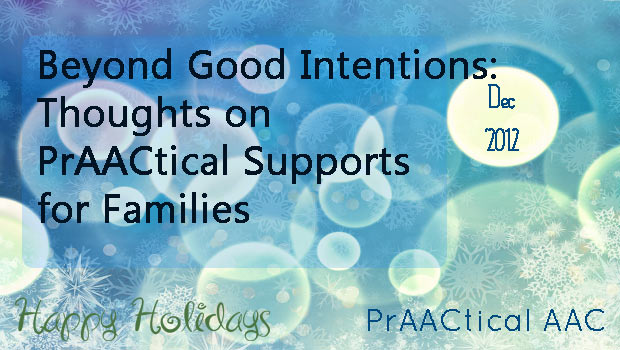
Sometimes it’s hard to know how best to help families of AAC learners. There can be a dynamic tension between the things we would like them to do to maximize the AAC learning process and what they can realistically accomplish given the competing demands of their busy lives. We really believe that having families do more AAC at home will enhance the communication learning, though I’m not  really sure that we have evidence to back up that belief. Nevertheless, we push for it. Nicely, of course. But we push.
really sure that we have evidence to back up that belief. Nevertheless, we push for it. Nicely, of course. But we push.
On a good day, it all works out. Or, at least it seems to. But does it really? Here are some things we’ve been thinking about.
- Each family has their own culture. Some families are highly structured, others are more spontaneous, and a few are downright chaotic. Whatever their nature, it is who they are and how they operate. We have to adjust what we ask them to do at home in the name of AAC learning, as well as our unspoken expectations.
- We may prefer them to be more flexible in some cases or follow a more predictable routine in others, but that may not fit with their culture. They have their own style and way of doing things that has (presumably) evolved to meet their own needs. To pressure families to be something other than what they are will make them feel guilty and that’s not what we’re about. Plus, it sets us back in what we both want to accomplish: better communication learning.
- It’s tempting to plow ahead with our recommendations, but when they collide with the natural culture of the family, we’re not likely to make a positive impact. Putting forth ideas, like specific practice activities or routines for using the AAC system, that are incompatible with how the family operates as a unit is just not going to work in the long run. We may get compliance early on, but that’s likely to peter out. And the damage to the relationship will likely outlive any short-term gains.
- We don’t see the downside to what we are asking families to do. We don’t see the extra stress of a parent who skips his/her walk
 to do interactive storybook reading before bedtime (not to mention the long-term health consequences that has). We are sometimes blinded to the paralyzing guilt that comes with not doing what the professionals expect because there aren’t enough hours in the day. We are not fully cognizant of the anxiety of what it’s like to take your kid to therapy knowing that you didn’t have the energy to practice. We’re blissfully unaware of these unintended consequences.
to do interactive storybook reading before bedtime (not to mention the long-term health consequences that has). We are sometimes blinded to the paralyzing guilt that comes with not doing what the professionals expect because there aren’t enough hours in the day. We are not fully cognizant of the anxiety of what it’s like to take your kid to therapy knowing that you didn’t have the energy to practice. We’re blissfully unaware of these unintended consequences. - Slow and sustainable changes may be the best route. It is SO hard for us to take a gradual approach to getting the AAC used 24/7. We want everything implemented consistently across environments. And we want it now. No, actually we wanted it yesterday. We know intellectually that these families struggle with the daily basics and everyday routines, but somehow we can’t give up on our quest to add one more ‘little’ thing to their day. We justify our expectations because we only want what’s best for the child, right? Think of what that implies. That the family doesn’t? Oops! Didn’t really think of it that way. We need to find a way to seriously manage our expectations. And that ain’t easy.
It’s not easy on any of us. There are no simple answers.With the way that special education and healthcare services are provided in our country, parents and professionals alike are overworked, overtired, and overwhelmed. How can we best work with families so that the kids do well and the cost to the family is not excessive? Like you, we’re wondering…
Filed under: PrAACtical Thinking
Tagged With: carryover, expectation, families, family culture, homeword, mutual respect, parents, relationships
This post was written by Carole Zangari

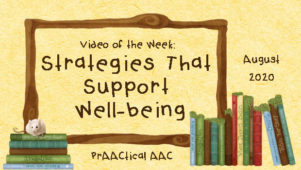
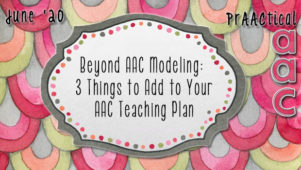
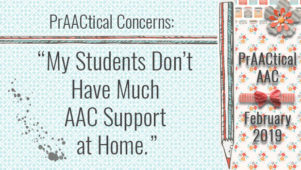
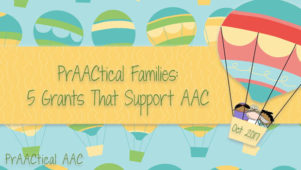
7 Comments
We have an AAC lending library for people with Down syndrome and through this 18 month time we have found exactly what you have stated so well to be true. Because of these facts we will be attempting to set up classrooms for success in the hopes that the implemented communication and learning system can help at home as parents see children interact and learn more with its use. It’s a big dilemma and I’m not sure how else to get around the challenges for our amazing families. One thing I do know for sure is that students with Down syndrome will receive a richer education if we set up their classroom for communicative success. “Behavior is communication” and we must help non verbal individuas express their needs so that they are not continuously looked at as behavior ridden. It is also critical that we do this because of the expressive/receptive gap in children with Down syndrome. They know more than the can express in most cases so we must get them talking in alternative ways until they can talk on their own. Family members still have fears about AAC and we are working hard to educate them. Thanks for a well written article.
Thanks for your comments, Nancy. It sounds like you have a wonderful program and are really mindful of supporting the participating families in meaningful ways. The idea of setting up environments where they can come to observe and learn is fantastic. We’d love to see pictures!
I wanted to, just once, go buy a toy without thinking what the “therapy” value was. I wanted my child to have because it was the cool thing. Fitting in everyone’s expectations is difficult. Sometimes you just want to snuggle and watch a movie with your child. The guilt a parent can feel for not always doing what every therapist, doctor and teacher expects is overwelhming. We have tried to set realistic goals so everyone wins. Remeber it is balance that moves you forward. Too much one way or the other and you fall.
Such great points, Kathleen! We definitely struggle with how to help and not invade on the family’s priorities, BUT it is very much a work in progress. Balance is an ongoing challenge, and reminders like yours help us find that center point. Thanks for taking the time to comment.
And then there are the parents who put so much stress on themselves with little support from the professionals in trying to implement the AAC. My son got his AAC through insurance with the help of the school district but I’m the only one teaching its implementation. He’s verbal but completely unintelligible to most of the world (I can now understand 50-75% of the time in context). His private SLP is working on the verbal aspect, his school SLP doesn’t really know what she’s doing with the AAC, and his SPED teacher is functionally illiterate when it comes to technology. Hopefully this changes as he enters preschool this fall (he is 3 and is transitioning to the preschool- his SPED teacher and SLP will change in the fall plus he will have a reg. ed preschool teacher) but I’m not being to hopeful. I’m going to try to teach him to use it enough to communicate whatever he wants through playing with it and modeling before school starts.
Well, that’s one of the big reasons that we took on this blogging venture. We have to find a way for more SLPs to get at least the basics on AAC intervention for these kids.
I know my comment is late for this posting, but I found it through Pinterest and I had to comment. My 8 year old daughter has apraxia from a rare genetic syndrome and has used (and rejected) her speech output device for 4 years. I am also about to start grad school to become an SLP myself. So as a parent and a clinician-in-training, I see your post from both sides. I appreciate your willingness to give families the benefit of the doubt. The guilt of not doing everything my daughter’s SLP, PT, and OT have asked haunts me every night when I go to bed. Every night!!! I know it’s frustrating to see families not tapping into the potential that communication devices have. SLP’s understand the possibilities and benefits that come with communication. Being parents of a special needs child and the extreme financial and emotional burdens it places on families (especially parents), can often feel crushing. It can destroy marriages and sometimes consumes a person’s sense of self. Thank you for being willing to see that sometimes just not getting divorced might be all some families can handle. Still give instruction and encouragement, but try and understand that sometimes a family is in survival mode and keeping relationships intact is the biggest priority for some of us.